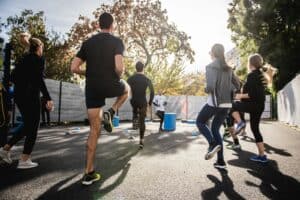Trail running is a liberating and invigorating experience, but it comes with its own set of challenges. To truly embrace the trails and optimize your performance while preventing injuries, a proper warm-up is non-negotiable. In this comprehensive guide, we’ll delve into the intricacies of how to warm up before a trail run, exploring each element of the process to ensure you’re ready for whatever the trail throws at you.
The Science Behind Warming Up

Understanding the science behind warming up is key to appreciating its importance. Before diving into dynamic stretches and cardio routines, let’s explore why warming up is crucial for your body.
Blood Flow and Its Role in Performance: Warming up increases blood flow, delivering essential oxygen and nutrients to your muscles. This boost in circulation prepares your body for the upcoming physical activity, enhancing both endurance and performance.
Dynamic Stretches for Trail Running
Dynamic stretches are your secret weapon for preparing major muscle groups, improving flexibility, and preventing injuries. Let’s break down some effective dynamic stretches for your pre-run warm-up routine.
Leg Swings for Limber Limbs: Begin with leg swings, a dynamic stretch targeting your lower body. Stand with your feet shoulder-width apart, and swing one leg forward and backward in a controlled motion. This warms up your hip flexors and enhances the range of motion in your legs.
Walking Lunges for Trail-Ready Legs: Introduce walking lunges to activate your leg muscles and promote proper form. Step forward with your left foot, ensuring both knees form 90-degree angles. Switch legs, gradually increasing the intensity to engage your quads, hamstrings, and glutes.
Butt Kicks and High Knees for Cardiovascular Warm-up: Incorporate butt kicks and high knees to elevate your heart rate gradually. These movements not only increase blood flow but also engage your cardiovascular system, ensuring your body is ready for the demands of trail running.
Trail-Specific Warm-up Tips

Trail running demands more than just generic warm-up routines. Tailor your warm-up to the unique challenges of trail terrain.
Balance and Stability Exercises: Include exercises that enhance balance, such as side lunges and one-legged stands. These prepare your body for uneven surfaces and sharp turns, reducing the risk of injuries.
Mindful Preparation for the Trail: Don’t neglect the mental aspect of warming up. Engage in mindfulness or visualization exercises to mentally prepare for the trail ahead. This not only sharpens focus but also contributes to better overall performance.
Cardiovascular Warm-up and Proper Form
A gradual increase in heart rate is essential for optimal performance. Start with a light cardiovascular warm-up and focus on maintaining proper form throughout.
Mountain Climbers for Cardiovascular Boost: Incorporate mountain climbers into your routine to elevate your heart rate while engaging your core and upper body. This dynamic exercise prepares your body for the cardiovascular demands of trail running.
Proper Form: Emphasize maintaining proper form during warm-up exercises. This not only reduces the risk of injuries but also ensures that your body is ready for the physical challenges ahead.
Timing and Duration: Listen to Your Body
The duration of your warm-up should be adapted to the trail difficulty and your individual fitness level. Pay attention to your body’s signals and adjust your warm-up accordingly.
Perceived Exertion and Gradual Intensity: Use perceived exertion as a guide during warm-up. Start slow and gradually intensify the warm-up to match the expected intensity of your trail run.
Static Stretching for Trail-Ready Muscles

Dynamic stretches set the stage, but static stretching adds the finishing touch to ensure your muscles are primed for the challenges of the trail. This section will delve into the significance of static stretching in your pre-run warm-up routine.
Leg Straight and Feet Shoulder Width: Incorporate static stretches that involve keeping your legs straight and maintaining a shoulder-width stance. For example, the hamstring stretch involves reaching down towards your toes with your legs straight, targeting the muscles in the back of your thighs. This helps elongate and prepare your muscles for the varied terrain of trail running.
Soft Tissues and Blood Vessels: Static stretching not only enhances flexibility but also promotes better blood circulation to the soft tissues. By holding each stretch for 15-30 seconds, you encourage the dilation of blood vessels, ensuring that oxygen-rich blood efficiently reaches every part of your muscles. This can significantly contribute to injury prevention and improved athletic performance.
Pre-Race Rituals: Elevating Athletic Performance
Your warm-up routine extends beyond the physical; it’s also an opportunity to fine-tune your mental state and set the stage for peak athletic performance.
Pre-Race Mental Conditioning: Consider incorporating pre-race mental conditioning into your warm-up routine. Visualization exercises, positive affirmations, and focused breathing can create a mental state conducive to peak performance. This aspect is particularly crucial for trail running, where mental resilience is as vital as physical preparedness.
Integration with Physical Therapy Techniques: For those with specific physical considerations or history of injuries, integrating elements of physical therapy into your warm-up routine can be transformative. Consult with a professional to tailor warm-up exercises that address your unique needs, ensuring that your body is not only warmed up but also supported in areas that may require extra attention.
Final Thoughts: How to Warm up Before a Trail Run
Warming up before a trail run is not just a ritual; it’s your ticket to unlocking your full trail-running potential. By understanding the science, incorporating dynamic stretches, focusing on trail-specific considerations, and maintaining proper form, you set the stage for a successful and injury-free trail adventure. Embrace the warm-up, embrace the trail, and let your next run be your best one yet. Your body will thank you, one warmed-up step at a time.
